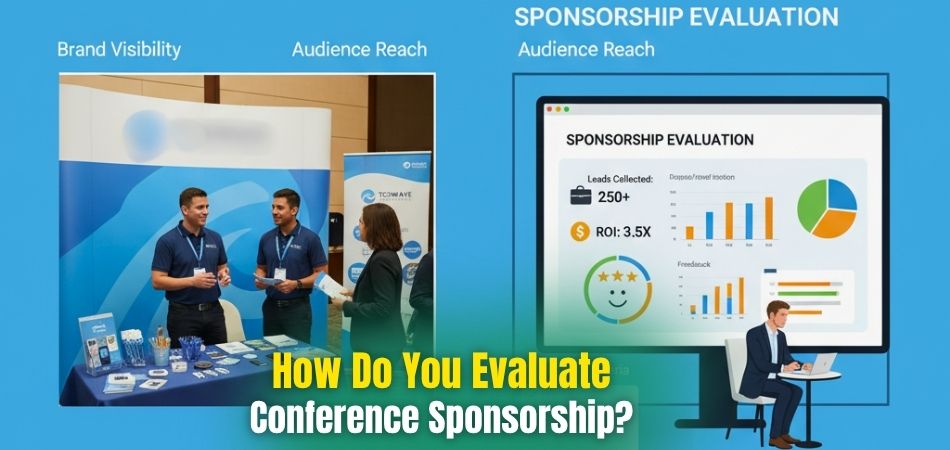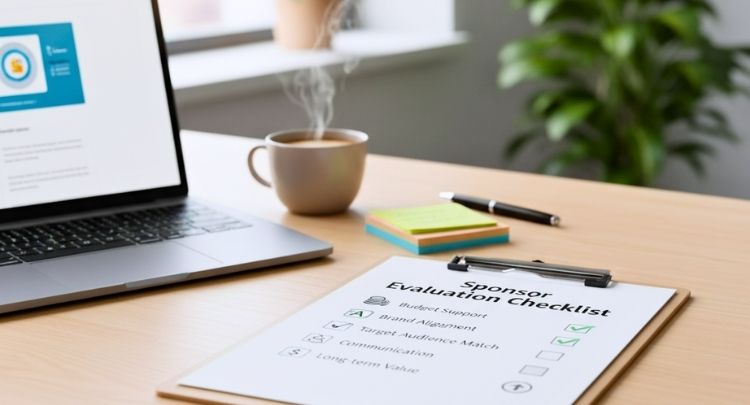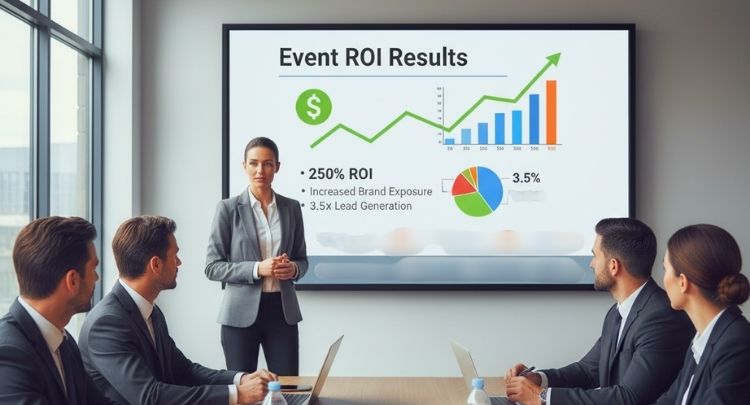Going to a conference is not just about being there. It’s about meeting people, getting your brand noticed, and building new chances for growth. Sponsorships can help with this, but they also cost money. That’s why it’s important to know if they are really worth it.
So, how do you evaluate conference sponsorship?
To evaluate conference sponsorship, first set clear goals like getting leads or growing brand awareness. Track things like booth visits, website clicks, or social media likes. Collect data before, during, and after the event. Compare results to your goals. Use the info to see if it was worth it and plan better next time.
Keep reading to learn practical strategies and tips that will help you measure conference sponsorship success with confidence.
How Do You Evaluate Conference Sponsorship?
Evaluating conference sponsorship helps businesses understand what they gain compared to what they spend. Clear methods make it simple to track results. With these steps, sponsors can improve decisions for future events.

Define Clear Goals
- Every sponsorship must begin with specific aims that align with business growth. Without direction, measurement feels scattered and confusing.
- Goals might include gaining qualified leads, reaching targeted markets, or building awareness. Simple definitions guide the process toward clear insights.
- Writing down goals brings focus and structure. It prevents last-minute guessing and makes final reviews more effective.
Track Booth Engagement
- Booth traffic reflects real interest from visitors. Keeping a daily count highlights the strongest event hours for interaction.
- Short surveys capture useful opinions and impressions. They provide direct feedback that complements simple numbers with meaningful stories.
- Interactive displays encourage people to stay longer. Longer engagement often connects directly with higher chances for lead conversion.
Measure Digital Impact
- Sponsors should record website traffic changes during events. Increased visits show online curiosity driven by the conference exposure.
- Social media likes, shares, and mentions matter greatly. They demonstrate reach while also sparking conversations across multiple channels.
- Email sign-ups are another digital signal. New subscribers indicate continuing interest that extends beyond the physical event itself.
Compare Costs With Returns
- Understanding total spending is critical for clarity. Gathering exact figures prevents mistakes when comparing to measurable benefits.
- Sponsors need to match each return to its cost. This calculation brings visibility into where money creates value.
- Without direct comparisons, decisions feel blurry and rushed. Data-driven reviews give confidence and reduce doubts about future investments.
Collect Lead Quality Data
- Numbers matter, but quality counts more. A hundred weak leads may bring less value than twenty strong ones.
- Asking about purchase timelines helps. Shorter timelines create faster returns, while longer ones require nurturing through campaigns.
- Evaluating lead relevance gives insight. If contacts match your buyer profile, sponsorship value becomes clearer and more convincing.
Review Audience Feedback
- Honest comments highlight what worked and what failed. Surveys allow attendees to explain feelings beyond hard performance numbers.
- Feedback from partners adds a deeper perspective. Other exhibitors often share useful insights about crowd behavior or interest levels.
- Collecting thoughts quickly ensures accuracy. People remember fresh experiences better than distant memories weeks after the event.
Benchmark Across Regions
- Looking beyond one location offers clarity. Comparing events in the United States, Germany, or conferences in Canada helps with context.
- Some regions attract bigger industry groups. Identifying those patterns helps companies decide which markets deserve larger investments.
- International benchmarks highlight cultural differences. Local responses may shift expectations and improve strategies for global sponsorship planning.
What KPIs Should You Track to Measure Sponsorship ROI?
Sometimes events feel exciting but confusing when it comes to real results. Companies often spend money hoping for good outcomes. Without proper checks, it becomes hard to know if the money worked well or simply disappeared. That is why learning about key tracking points is so important.
Leads Collected
One important point is the number of leads you collect. Leads are people who may buy your product later. Collecting many names feels good, but the quality of those names matters more. Always focus on finding leads that truly match your business needs.
Booth Visitors
If you have a booth, count how many people visit. Visitors show real interest in your brand. More visitors usually mean you did something right with your design or activities. A booth that attracts crowds always helps you connect with possible buyers.
Website Clicks
Many events push people to search online after they meet you. That’s why website clicks are useful. If people look up your site, it shows they want to know more. A steady rise in traffic proves the event grabbed attention.
Social Media Buzz
When people talk about you online, it matters. Likes, comments, and shares show people noticed your brand. Social buzz is proof that your event’s presence reached beyond the physical location. It also keeps your name alive after the event ends.
Sales Closed
Sometimes leads turn into actual buyers quickly. Tracking closed sales is a clear way to measure return. If you close sales soon after an event, the sponsorship worked well. Even small numbers can be powerful when they bring steady income.
Brand Awareness
Not every gain is about money. Sometimes events build brand awareness. This means people simply remember your name better. Recognition helps in the long run, making future sales and deals easier to achieve.
Partner Feedback
Partners and team members notice different things. Ask them how they felt about the event. Their thoughts add another angle you might miss. Honest feedback can shape better plans for the next sponsorship.
How to Create a Sponsor Evaluation Checklist?
Choosing the right sponsor can feel tricky when so many factors come into play at once. A checklist makes the process smoother by giving structure and reducing the chances of confusion. It also ensures decisions stay clear, fair, and consistent. With simple steps, anyone can create a reliable sponsor evaluation checklist.
Relevance and Fit
Always check if the sponsor matches the event’s theme and goals. If their products or services clash, the partnership may look forced. Sponsors who align with your values create a natural connection. That connection makes the event stronger and more trustworthy.
Rules and Ethics
Every sponsorship needs to follow policies and basic fairness. Check that the deal does not break any important rules. It should also avoid unfair practices or hidden advantages. Keeping ethics at the center helps maintain long-term trust.
Sponsor Reputation
A sponsor with a good name adds value to your event. If the sponsor is stable and trusted, people feel confident. Avoid working with sponsors who have financial troubles or negative stories. Reputation can easily affect how others see the event.
Agreement Details
The sponsorship agreement should always be clear and simple. It must state the start and end dates properly. Benefits for both sides should be written down and easy to understand. Avoid agreements that leave room for confusion or unfair demands.
Trust and Privacy
Sponsorships should never risk people’s trust or privacy. Information shared must be kept safe and not be misused. If the public feels uncomfortable, the event could lose respect. Strong privacy rules keep the partnership transparent and dependable.
Benefits and Funds
Sponsors should explain how they will use their funds. Their contribution should match the benefits they receive. Fair acknowledgment keeps sponsors happy and avoids future problems. Balancing both sides ensures a healthy and positive relationship.
Risk Check
Every partnership carries some risk, so it must be reviewed. Confirm if there is insurance to cover possible issues. Think about financial risks as well as reputational ones. Handling risks early makes the event safer for everyone.
Measuring Success
A checklist not only ensures smooth planning but also helps in tracking results. For example, evaluating conference sponsorship success often includes reviewing how well sponsors supported the goals. Clear measures can guide improvements for future events. Using evaluation this way brings lasting value.
Best Methods to Collect Sponsor Feedback After Events
Every event ends with memories, but what truly matters is learning from those who helped make it possible. Sponsors invest their money, time, and trust, so knowing their thoughts becomes important. A strong feedback process helps uncover hidden strengths and weak points. With the right methods, feedback turns into real improvement for future events.
Feedback Surveys
Surveys are quick and simple tools to gather sponsor opinions. They often mix multiple-choice questions with open-ended ones. Sending them soon after the event increases the chances of getting honest responses. Incentives like gift cards or early access can improve participation rates.
Interviews and Groups
Personal conversations create a deeper understanding that surveys sometimes miss. One-on-one interviews or small focus groups allow detailed discussions. Sponsors often share meaningful suggestions when given space to speak openly. These talks work well in person or through online meetings.
Feedback Boxes
Placing physical or digital boxes at the event helps gather immediate thoughts. Sponsors can drop in quick ideas without pressure. It captures impressions that might be forgotten later. Easy access makes sharing feedback less formal and more natural.
Social Monitoring
Many sponsors watch how people react online during events. Checking hashtags, posts, or comments shows public views about their brand. This method gives indirect feedback that adds extra context. It also reveals real-time reactions from the wider audience.
Follow-Up Calls
Direct phone calls or personalized emails make sponsors feel valued. These conversations often reveal issues that forms cannot cover. A simple check-in shows care and builds trust. Sponsors appreciate it when organizers take time to listen beyond formal surveys.
How to Present ROI Results to Prospective Sponsors?
Sharing results with sponsors is more than just numbers on a page. It is about showing clear value. Sponsors want to see how their investment worked and if it matched their goals. With the right approach, results can inspire long-term trust.
Align with Goals
Start by restating what was promised at the beginning. Sponsors like seeing their goals addressed directly. Show how those promises matched the actual outcomes in clear examples. This makes it easy to connect efforts with success.
Show Metrics
Numbers are powerful when they are easy to read. Share data such as leads, conversions, and clicks. Use simple comparisons between before and after the sponsorship. Hard facts give confidence that their investment truly delivered results.
Add Insights
Numbers alone do not tell the whole story. Include sponsor or audience feedback to highlight feelings and reactions. Social media comments or testimonials can show deeper value. These stories make the data more personal and relatable.
Visual Reports
Data becomes easier when shown in visuals. Use charts, graphs, and colorful designs to explain big numbers quickly. Sponsors can scan visuals faster than text-heavy pages. Good graphics leave a stronger impression during presentations.
Tell Stories
Frame the results like a success story. Show how their support created a real impact for the event. Include examples or small case studies when possible. A story makes numbers memorable and easier to understand.
Long-Term Value
Do not just talk about the event alone. Show how the results carry forward into lasting benefits. This could include repeat customers or a stronger market standing. Here, you can also connect the discussion with the wider benefits of conference sponsorships to highlight ongoing returns.
Honest Review
Be open about what worked and what did not. Sponsors respect transparency even if all targets were not reached. Highlighting small challenges shows fairness and maturity. This honesty helps build stronger partnerships over time.
Tailored Reports
Every sponsor is different, so customize your presentation. Use examples and data that match their industry or goals. Show only the metrics most useful to them. A tailored approach feels personal and more convincing.
FAQs about Ways to Evaluate Conference Sponsorship
Evaluating sponsorships often raises practical questions for organizers and businesses. Beyond goals and metrics, there are everyday details that matter. These FAQs will help you understand the process in a simple, clear, and actionable way.
How Do You Compare Sponsorship Packages?
To compare packages, look at the benefits offered, such as booth space, speaking slots, or promotions. Weigh them against the cost and your goals. Choose the package that provides the best balance between investment and visibility.
What Role Does Audience Demographics Play?
Audience demographics matter because sponsors want access to the right people. Check details like age, profession, and interests. If attendees match the sponsor’s target market, the sponsorship creates stronger value. This ensures better results from the partnership.
Why Should You Monitor Competitor Sponsorships?
Competitors at the same event give important clues. Watch what they spend on booths, ads, or presentations. Comparing these activities helps you understand trends and market standards. This review guides smarter choices for your own sponsorship investments.
How Can You Track Media Coverage?
Sponsors gain value when events are covered by media outlets. Track mentions in newspapers, blogs, or local TV. Count positive mentions and estimate their reach. Strong coverage proves the event gave sponsors wide recognition beyond the audience.
What Is The Importance Of Networking Outcomes?
Networking outcomes are often overlooked but highly valuable. Measure how many meaningful partnerships or business introductions came from the event. Strong networking opportunities increase sponsorship worth. This adds value even if other numeric metrics appear lower.
How Do You Measure Staff Involvement?
Staff engagement reflects how useful the sponsorship was internally. Track if employees gained skills, confidence, or new business leads. Staff satisfaction often connects to event success. Positive involvement adds hidden value often missed in standard evaluation checklists.
Why Should You Evaluate Post-Event Partnerships?
Sometimes sponsorships lead to unexpected collaborations. Review whether the event opened doors for ongoing partnerships or projects. These benefits stretch beyond the event itself. Recognizing them ensures you see the complete value of sponsorship involvement.
How Can You Use Benchmarks Effectively?
Benchmarks provide context for results. Compare your event outcomes with past sponsorships or similar events. This shows growth and reveals weak points. Benchmarks keep evaluations realistic, preventing overestimation or underestimation of sponsorship success.
Final Considerations
Not every sponsorship gives the same results. That’s why it’s important to check what worked and what didn’t. Use simple goals, keep track of numbers, and ask sponsors for honest feedback. This helps you see the real value of your efforts.
Knowing how do you evaluate conference sponsorship makes planning easier and smarter next time. When you mix facts with real opinions, you get a clear picture. Sponsors feel happy when they see results that matter. This builds trust and makes them want to come back again.







